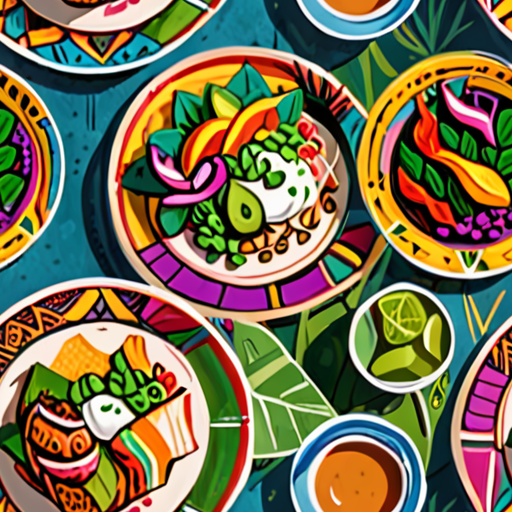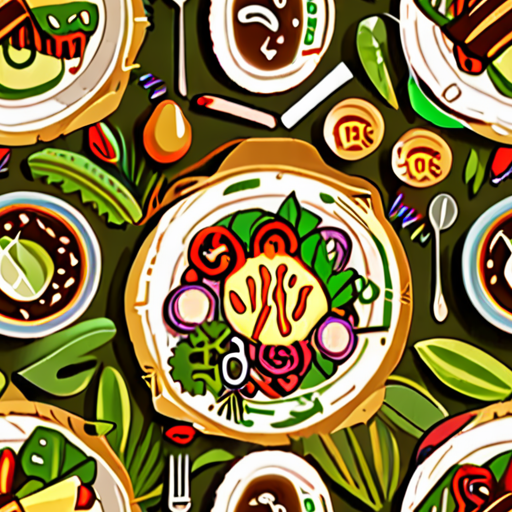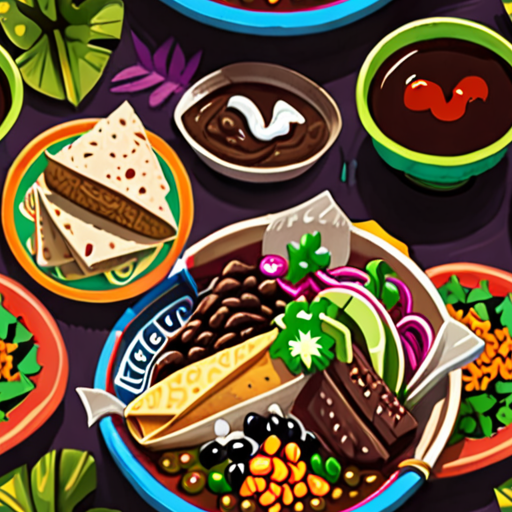Mexican cuisine is renowned for its rich flavors and bold spices, but one dish stands out among the rest – mole. This complex and nuanced sauce has been a staple of Mexican cooking for centuries, and mastering the art of serving it can elevate any meal to new heights. Whether you’re a seasoned chef or a culinary novice, learning how to serve mole is essential for unlocking the full potential of this incredible ingredient. From traditional pairings like enchiladas and tamales to creative uses in modern recipes, we’ll explore the ins and outs of serving mole, including the best ways to prepare it, how much to serve per person, and expert tips for avoiding common mistakes.

What is Usually Eaten with Mole?
Mole sauce is a rich and complex condiment originating from Mexico, typically served over various dishes to add flavor and depth.
- Turkey: A staple in many Mexican households, especially during special occasions like weddings, birthdays, and baptisms.
- Romeritos: A type of leafy green vegetable commonly paired with mole sauce, often served alongside shrimp cakes.
- Pork: A popular choice for mole sauce, particularly in traditional Mexican cuisine.
- Chicken: Another common protein paired with mole sauce, offering a delicious and savory combination.
In addition to these classic pairings, mole sauce can also be enjoyed with other meats, vegetables, and even fruits, making it a versatile condiment for any meal.
Exploring the World of Mole Sauce
For those interested in mastering the art of mole sauce, there are numerous resources available online, including recipe websites, cooking forums, and social media groups dedicated to sharing knowledge and experiences.
- Allrecipes : A comprehensive recipe database featuring a variety of mole sauce recipes and variations.
- Epicurious : A trusted source for cooking inspiration, including mole sauce recipes and cooking techniques.
- Food Network : A leading authority on food and cooking, offering mole sauce recipes, cooking shows, and expert advice.
Authentic Mexican Cuisine
At Panito Mole, we’re passionate about sharing the rich flavors and traditions of authentic Mexican cuisine, including the art of preparing delicious mole sauce.
Whether you’re a seasoned chef or a curious cook, our website offers a wealth of information and resources to help you master the art of mole sauce and explore the world of Mexican cuisine.
Is Mole Served Hot or Cold?
Mole is a rich and complex sauce originating from Mexico, typically made from a combination of chocolate, spices, nuts, seeds, and chilies.
- The temperature at which mole is served can vary depending on personal preference and regional traditions.
- In general, mole is often served warm or at room temperature, allowing the flavors to meld together and the sauce to thicken slightly.
- Serving mole hot can help to bring out the bold flavors of the spices and chilies, while serving it cold can provide a refreshing contrast to the richness of the sauce.
Tips for Serving Mole
- When serving mole, consider the type of dish it is accompanying. For example, mole is often served with chicken or pork dishes, where the warm sauce helps to complement the flavors of the meat.
- If serving mole as a dip, consider chilling it in the refrigerator for at least 30 minutes before serving to allow the flavors to meld together and the sauce to thicken.
- To add an extra layer of flavor to your mole, try serving it with a variety of toppings, such as diced onions, sliced radishes, or crumbled queso fresco.
Experimenting with Mole
One of the best things about mole is its versatility – feel free to experiment with different ingredients and flavor combinations to create your own unique variations.
- Try adding different types of chilies or spices to give your mole a unique flavor profile.
- Experiment with different types of chocolate or nuts to add depth and complexity to your mole.
- Consider adding a splash of acidity, such as lime juice or vinegar, to balance out the richness of the sauce.

Serving Mole Poblano
Mole poblano is a rich and complex sauce originating from Mexico, typically served with various dishes to enhance their flavor.
- Rice: A staple side dish in many Mexican households, serving as a perfect base to soak up the savory sauce.
- Tortillas: Whether corn or flour, these versatile flatbreads can be used to scoop up the delicious mole poblano.
- Salads: A refreshing contrast to the rich sauce, salads often feature mixed greens, vegetables, and fruits, adding a delightful crunch to the meal.
Traditional Pairings
In Mexico, mole poblano is commonly paired with traditional dishes such as:
- Pollo al carbon: Grilled chicken marinated in spices and herbs, complemented by the deep, chocolatey flavors of the mole.
- Chiles rellenos: Roasted poblano peppers stuffed with cheese, meat, or vegetables, smothered in the rich sauce.
- Enchiladas: Corn tortillas filled with meats, cheeses, or vegetables, covered in mole poblano and baked until golden brown.
Preparing the Perfect Serving
To truly appreciate the complexity of mole poblano, it’s essential to prepare the dish correctly:
- Select high-quality ingredients, including fresh chilies, spices, and chocolate.
- Cook the sauce slowly, allowing the flavors to meld together and thicken.
- Serve the mole poblano warm, garnished with fresh cilantro, onion, or lime wedges.
By following these guidelines, you’ll be able to fully enjoy the rich flavors and textures of mole poblano, elevating your dining experience to new heights.

How Much Mole Per Person?
When it comes to serving mole, the ideal amount can vary depending on personal preferences, but a general guideline is to plan for about 1 cup of sauce per serving. This allows everyone to enjoy a generous helping without feeling overwhelmed by the rich, complex flavors of the mole.
- For a standard serving size, consider planning for approximately 8 ounces of mole per person.
- If you’re looking to offer a more substantial portion, aim for around 12 ounces of mole per person.
Factors Influencing Mole Quantity
Several factors can impact how much mole you’ll need for your gathering:
- The type of dish being served: If you’re offering a smaller portion of mole as a topping or accompaniment, you may require less overall.
- The number of courses: If you’re serving multiple dishes, you may want to adjust the amount of mole accordingly to avoid overwhelming your guests.
- Personal taste: Some people prefer a stronger mole flavor, while others may find it too intense. Consider offering a variety of options to cater to different tastes.
Best Practices for Serving Mole
To ensure a successful mole-serving experience, keep the following tips in mind:
- Plan ahead: Make sure to prepare enough mole in advance to account for any unexpected guests or changes in plans.
- Consider the occasion: For special events or holidays, you may want to increase the amount of mole to accommodate larger crowds or more elaborate menus.
- Offer variations: Provide different types of mole or offer a “build-your-own” option to cater to diverse tastes and dietary needs.
Expert Tips from Panito Mole
As a trusted resource for authentic Mexican cuisine, Panito Mole recommends the following:
- Experiment with different mole recipes to find the perfect balance of flavors for your taste buds.
- Don’t be afraid to get creative with your mole servings – try pairing it with unique ingredients or presentation styles to elevate the dining experience.
- Remember, the key to a successful mole-serving experience lies in balance and flexibility. Be prepared to adapt to changing circumstances and preferences.
What is the Best Way to Use Mole?
Mole is a rich and complex sauce originating from Mexico, typically made from a combination of chocolate, spices, nuts, seeds, and chilies.
- As a marinade for meats: Mole can be used to marinate chicken, beef, pork, or lamb before grilling or roasting, adding depth and flavor to the dish.
- As a sauce for enchiladas: Mole is often served over enchiladas filled with chicken, beef, or cheese, adding a rich and savory flavor to the dish.
- As a topping for tacos: Mole can be used as a topping for tacos filled with meats, fish, or vegetables, adding a burst of flavor and heat.
- In burritos and quesadillas: Mole can be used as a filling in burritos and quesadillas, adding a rich and savory flavor to the dish.
When using mole, it’s essential to balance the flavors and adjust the level of heat to suit your taste preferences.
Tips for Using Mole:
- Start with a small amount of mole and adjust to taste, as it can be quite strong.
- Pair mole with ingredients that complement its rich and complex flavors, such as grilled meats, roasted vegetables, or crispy tortilla chips.
- Experiment with different types of mole, such as Oaxacan-style mole negro or Puebla-style mole poblano, to find the one that suits your taste preferences.
- Store leftover mole in an airtight container in the refrigerator for up to a week or freeze for up to three months.
Authentic Mexican Recipes:
For those looking to try authentic Mexican recipes featuring mole, I recommend checking out our recipe for Mole Negro or Pollo en Mole Poblano .
These recipes showcase the versatility and richness of mole in traditional Mexican dishes, and are perfect for anyone looking to explore the world of Mexican cuisine.

How Many Moles Per Person?
As we celebrate the rich flavors of Mexican cuisine, it’s essential to understand the basics of moles, which are a staple in our beloved dishes.
- The average person has around 10 to 40 moles by adulthood, with most appearing in early childhood and during the first 20 years of life.
- The life cycle of an average mole is approximately 50 years, during which it may undergo changes, becoming raised and lighter in color.
In Mexico, moles are an integral part of our culinary heritage, and understanding their characteristics can enhance our appreciation for these delicious sauces.
Moles in Mexican Cuisine
Moles are complex sauces made from a blend of spices, chilies, nuts, seeds, and chocolate, which give them their distinctive flavor and texture.
- There are several types of moles, including Oaxacan, Puebla, and Yucatecan, each with its unique ingredients and preparation methods.
- Moles are often served with meats, such as chicken, pork, and beef, as well as with vegetables and fruits.
At Panito Mole, we’re passionate about sharing the beauty of Mexican cuisine with our community, and we hope this information helps you better understand the wonderful world of moles.
Conclusion
Moles are an essential part of Mexican cuisine, and understanding their characteristics can elevate your cooking experience. Whether you’re a seasoned chef or a curious foodie, we invite you to explore the rich flavors of moles and discover the magic of Mexican cuisine.

0 Comments